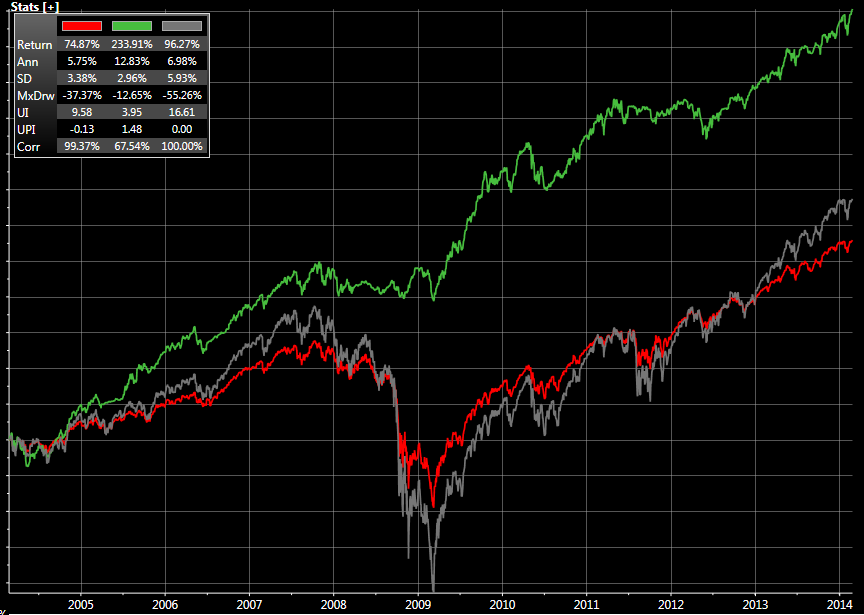Leveraging Investment Portfolios
Summary
In this post, we’ll model a 1x leveraged investment portfolio of JNK – SPDR Blmbg Barclays High Yield Bond ETF. Next, we’ll model using a 50 / 200 moving average of JNK to add and remove the leverage.
Said in simple terms, we’ll leverage the portfolio when the 50 day is over the 200 day average. When the 50 day drops below the 200, we’ll de-lever and just hold JNK.
All modeling is done with FT Cloud and FTCloud’s static model. Watch a quick overview of the Static Model here. Sign up for a free trial here:
What is Leverage
Leveraging a portfolio is when an investor borrows money to purchase securities. If the securities purchased with borrowed money appreciate, you enhance your profits without using your own capital. If the purchased securities produce a loss, you repay the debt at par and magnify the loss on investment.
Fire In Your Living Room
Leverage can greatly magnify gains and losses. Certain investors live and die by leverage, but it’s not something to employ lightly. I recently had a user describe it to me like this: “It’s like building a fire in the middle of your living room. While that fire will heat your house and keep you warm, if you don’t keep on top of it will burn the place down.”

Modeling Leverage
We’ll jump right into FT Cloud. We’ll use the Static Model to accomplish our goals.

First, navigate to the (1) Data >> Static Model tab. Then look in the (2) lower middle of the screen for the leverage details. The leverage info gives you the % leverage, margin rate, and % cash in the portfolio.

To create a leveraged model, allocate weighting to the portfolio that adds to more than 100%. The above picture shows an example portfolio with a 250% allocation.
Relating this to a $100,000 portfolio, the above example would have the following positions:
SPY – $150,000
TLT – $100,000
Total – $250,000
Margin Rate

The margin rate is the cost of borrowing funds. This is expressed in an annual percentage rate. The interest compounds each time the portfolio rebalanced. A monthly rebalance has monthly compounding interest and a weekly model has weekly compounding interest.
Set the global margin rate on the Login>>Advanced Options screen.
Leverage is the total leverage on the portfolio. In the above 250% leverage example, $100,000 is the original capital position, and the $150,000 is the leveraged position. $150,000 / $250,000 = 150% leverage.
The cash position is the balance in cash for any models that have under 100% allocations. A model with a single SPY position of 80% will show a cash position of 20%.
Calculate the Portfolio

Once we have our details dialed in, we need to crunch the portfolio. In FT Cloud, we’ll create an FNU by clicking the “Create FNU” button.
This saves an FNU file to your local disk and adds a new ticker to your FT Cloud database. The value in the “ticker” field is used as the portfolio’s new ticker. Use this ticker anywhere in FT Cloud.
Checking the Work
Open Log will open the windows folder where all leveraged model logs are stored. The leverage log is a .CSV file that has the following columns:
- Date – Market date of values
- Non Levered Portfolio – value of the underlying non-levered static model. In the above 250% example, this would be the values of a 60% SPY, 40% TLT portfolio. To calculate the model FT Cloud creates a non levered static model with the following weightings: $150k / $250k = 60% SPY and $100k / $250k = 40% TLT portfolio. Once this 60/40 portfolio is calculated, then FT Cloud applies 150% leverage to the 60/40 portfolio.
- Running Total Non Levered Portfolio – The daily value of the un-levered portion of the portfolio. This is a “show your work” value. It acts oddly by jumping in value at the beginning of every month. This is due to the resetting of the un-levered value to the previous day’s [Levered Portfolio Value] (plus the day’s price change)
- Original Borrowed Amount – the amount borrowed at the beginning of the investment period. This value resets every time the portfolio is rebalanced. This value change does not change throughout the period. ie. you borrow a fixed dollar amount on the first day of the month, then repay that same fixed dollar amount at the end of the period.
- Borrowed Amount Value – the daily value of the borrowed funds. On the first day, the original borrowed amount is invested with the same allocations as the nonlevered portfolio. Each day the [Borrowed Amount Value] changes according to the change of the [Non Levered Portfolio]
- Period Cost – the fractional portion of the annual interest charged over the investment period. This also remains unchanged during the period. Since we borrow a fixed value on day 1, the interest is charged off that fixed value. This is calculated as:
( [margin rate] / [rebalance frequency] ) * [Original Borrowed Amount] - Daily Cost – the period cost divided by the number of market days in the investment period. For the same reasons, this value does not change during the investment period.
- Net Return on Borrowed Amount – This is the result of the following equation:
[Borrowed Amount Value] – [Original Borrowed Amount] – [Daily Cost] - Levered Portfolio Value – This is the result of the following equation:
( [Previous Day Running Total Non Levered Portfolio] * [Daily return of Non Levered Portfolio] ) + [ Net Return on Borrowed Amount]
Click the link below for a google sheet log of the above leverage model. Columns A-I shows the regular log values. Columns K-Q show the work of how the values are derived.






